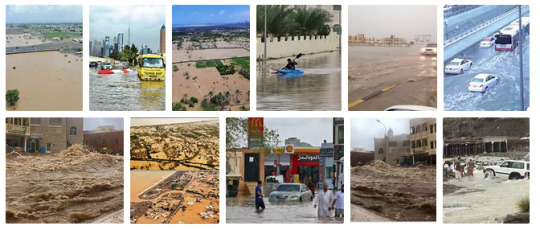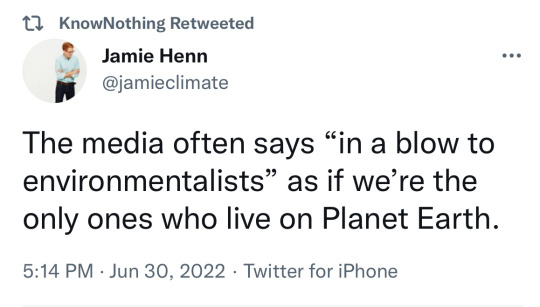Text
"As governments move to address climate change, which brings with it more intense rainfall, longer bushfire seasons and declining biodiversity, here are five of the big climate and environment issues to keep your eye on in 2024.
Global mass bleaching
First Nations water rights
Greenwashing and resource claims
Biodiversity protection
Offshore energy projects" ABC
#australia#jail climate criminals#we want climate action now#climate change#cambio climático#climate crisis#prepare for climate change#greenwashing#big oil#fossil fuel industry#plastic#climate washing#floods#climate activism#calentamiento global#medio ambiente#IPPC#climate hope#sea level rise#late stage capitalism#victims of capitalism#klimakatastrophe#klimawandel#changement climatique#qihou bianhua#izmeneniye klimata#cambiamento climatico#気候変動#जलवायु परिवर्तन#jalavaayu parivartan
2 notes
·
View notes
Text
#jail climate criminals#climate change#climate crisis#we want climate action now#klimawandel#changement climatique#klimakatastrophe#jailclimatecriminals#cambio climático#qihou bianhua#single use plastics#plastics industry#plastic pollution
2 notes
·
View notes
Text
#social justice#jail climate criminals#climate change#climate crisis#we want climate action now#klimawandel#changement climatique#klimakatastrophe#jailclimatecriminals#cambio climático#qihou bianhua#single use plastics#plastics#plastic pollution
0 notes
Text
Excerpt from this story from the New York Times:
For the past two years, world leaders, economists and activists have called for sweeping overhauls to the World Bank and the International Monetary Fund that would make the two lending institutions more adept at combating climate change.
Discussions about how to reform lumbering multilateral bureaucracies can get tedious quickly. But ultimately the debates are all about money. How to make more money available for developing nations that are being battered by extreme weather? And how to make sure poor countries don’t spend too much money servicing their debt?
Experts estimate that at least $1 trillion a year is needed to help developing countries adapt to hotter temperatures and rising seas, build out clean energy projects and cope with climate disasters.
“For many countries, they will only be able to implement strong new climate plans if we see a quantum leap in climate finance this year,” Simon Stiell, the United Nations climate chief, said in a speech last week.
Starting in 2022, a burst of activity had made the prospect of such a quantum leap seem within reach.
Policymakers and economists gathered in Barbados and hashed out an ambitious reform agenda. The president of the World Bank stepped down after coming under fire for not doing enough to address climate change, and was replaced by an executive who promised to embrace climate work. Emmanuel Macron, the president of France, hosted a summit aimed at building momentum for the work.
But at the annual spring meetings of the World Bank and the I.M.F., which are taking place in Washington this week, reality is setting in.
While more money has become available to address climate issues over the last year or so, the sweeping reforms many had envisioned are proving to be out of reach.
Some of that is a process problem. Overhauling 80-year-old international institutions with complicated governance structures and tens of thousands of employees is no small task.
But much of the challenge comes back to money. So far, the countries that control the World Bank — including the United States, Germany, China and Japan — have not allocated huge new sums for climate issues in the developing world, and the private sector has not stepped in to fill the gap.
“The numbers do not show the kind of progress that we really need,” said Rachel Kyte, a visiting professor at Oxford and former World Bank executive. “We’ve got to get a little bit more radical.”
#jail climate criminals#we want climate action now#climate change#cambio climático#climate crisis#prepare for climate change#greenwashing#big oil#fossil fuel industry#plastic#climate washing#floods#climate activism#calentamiento global#medio ambiente#IPPC#climate hope#sea level rise#late stage capitalism#victims of capitalism#klimakatastrophe#klimawandel#changement climatique#qihou bianhua#izmeneniye klimata#cambiamento climatico#気候変動#जलवायु परिवर्तन#jalavaayu parivartan#das Alterações Climáticas
6 notes
·
View notes
Text
Excerpt from this story from Inside Climate News:
Reduced snow cover and vegetation shifts in the Alps, driven, to some degree, by climate change, are leading some mountain ecosystems to struggle to hold onto nutrients that feed vegetation, a new study shows.
The study, published in the journal Global Change Biology last month, shows that alpine ecosystems may have trouble retaining vital elements like nitrogen that are necessary for maintaining plant growth and biodiversity.
“It’s really added to the literature, arguing that it’s really important to understand the interaction among the different elements of an ecosystem and what the effects of climate change will be,” Olivier Dangles, author of the 2023 book Climate Change on Mountains, said of the study.
he warming of alpine grasslands, which is occurring at double the global average rate, is causing significant disruptions in the ecosystem functions of plants and soils. This accelerated warming is leading to significant decreases in snow cover and promoting the swift upward migration of small shrubs like heather.
The cycle of nitrogen between plants and soil microbes across seasons is vital for retention of the element in alpine ecosystems.
“The seasonal aspect is really important in these mountains, and climate change can really disrupt those seasonal processes,” said Arthur Broadbent, a researcher at the University of Manchester and the lead author of the study. “That can throw the ecosystem a little bit out of whack, and potentially lead to not being able to retain crucial nutrients like nitrogen as well as it could before.”
#alpine ecosystems#climate change#jail climate criminals#we want climate action now#cambio climático#climate crisis#prepare for climate change#greenwashing#big oil#fossil fuel industry#plastic#climate washing#floods#climate activism#calentamiento global#medio ambiente#IPPC#climate hope#sea level rise#late stage capitalism#victims of capitalism#klimakatastrophe#klimawandel#changement climatique#qihou bianhua#izmeneniye klimata#cambiamento climatico#気候変動#जलवायु परिवर्तन#jalavaayu parivartan
4 notes
·
View notes
Text
Excerpt from this story from Inside Climate News:
Reduced snow cover and vegetation shifts in the Alps, driven, to some degree, by climate change, are leading some mountain ecosystems to struggle to hold onto nutrients that feed vegetation, a new study shows.
The study, published in the journal Global Change Biology last month, shows that alpine ecosystems may have trouble retaining vital elements like nitrogen that are necessary for maintaining plant growth and biodiversity.
“It’s really added to the literature, arguing that it’s really important to understand the interaction among the different elements of an ecosystem and what the effects of climate change will be,” Olivier Dangles, author of the 2023 book Climate Change on Mountains, said of the study.
he warming of alpine grasslands, which is occurring at double the global average rate, is causing significant disruptions in the ecosystem functions of plants and soils. This accelerated warming is leading to significant decreases in snow cover and promoting the swift upward migration of small shrubs like heather.
The cycle of nitrogen between plants and soil microbes across seasons is vital for retention of the element in alpine ecosystems.
“The seasonal aspect is really important in these mountains, and climate change can really disrupt those seasonal processes,” said Arthur Broadbent, a researcher at the University of Manchester and the lead author of the study. “That can throw the ecosystem a little bit out of whack, and potentially lead to not being able to retain crucial nutrients like nitrogen as well as it could before.”
#alpine ecosystems#climate change#jail climate criminals#we want climate action now#klimawandel#klimakatastrophe#changement climatique
4 notes
·
View notes
Text
"Heat stored underground in caverns can be set aside in Finland’s summer months to be re-used during frigid winters thanks to a state-of-the-art ‘seasonal energy’ storage facility.
Slated for construction this summer near Helsinki, it will be the largest in the world by all standards and contain enough thermal energy to heat a medium-sized city all winter.
Thermal exchange heating systems, like those built underground, or domestic heat pumps, are seen as the most effective way available of reducing the climate-impact of home heating and cooling.
Their function relies on natural forces or energy recycling to cool down or heat up water and then using it to radiate hot or cold energy into a dwelling.
In Vantaa, Finland’s fourth largest city neighboring the capital of Helsinki, the ambitious Varanto seasonal energy storage project plans to store cheap and environmental friendly waste heat from datacenters, cooling processes, and waste-to-energy assets in underground caverns where it can be used to heat buildings via the district heating network whenever it is needed.
In Finland and other Nordic countries, the heat consumption varies significantly between seasons. Heat consumption in the summertime is only about one-tenth of the peak load consumption during the cold winter months.
Varanto will utilize underground caverns equal in space to two Maddison Square Gardens—over a million cubic meters—filled with water heated by this waste heat and pressure that will allow the water to reach temperatures of up to 300 degrees Fahrenheit without the water boiling or evaporating.
youtube
“The world is undergoing a huge energy transition. Wind and solar power have become vital technologies in the transition from fossil fuels to clean energy,” says Vantaa Energy CEO Jukka Toivonen.
“The biggest challenge of the energy transition so far has been the inability to store these intermittent forms of energy for later use. Unfortunately, small-scale storage solutions, such as batteries or accumulators, are not sufficient; large, industrial-scale storage solutions are needed. Varanto is an excellent example of this, and we are happy to set an example for the rest of the world.” ...
“Two 60-MW electric boilers will be built in conjunction with Varanto,” adds Toivonen. “These boilers will be used to produce heat from renewable electricity when electricity is abundant and cheap. Our heat-producing system will work like a hybrid car: alternating between electricity and other forms of production, depending on what is most advantageous and efficient at the time.”
... Construction of the storage facility’s entrance is expected to start in summer 2024, while it could be operational as early as 2028."
-via Good News Network, April 12, 2024. Video via VantaanEnergia, March 10, 2024
365 notes
·
View notes
Text

"The heavy rainfall has instead been blamed on climate change in the region, with global warming meaning that severe weather events such as this are “likely to become much heavier and worse” in the years to come." Owen Bellwood
#jail climate criminals#we want climate action now#climate change#cambio climático#climate crisis#prepare for climate change#greenwashing#big oil#fossil fuel industry#plastic#climate washing#floods#climate activism#calentamiento global#medio ambiente#IPPC#climate hope#sea level rise#late stage capitalism#victims of capitalism#klimakatastrophe#klimawandel#changement climatique#qihou bianhua#izmeneniye klimata#cambiamento climatico#気候変動#जलवायु परिवर्तन#jalavaayu parivartan#das Alterações Climáticas
0 notes
Text


I hope this goes somewhere soon
#switzerland#women#climate change#even this wretched country could be forced to do more#i hope more cases like this get put forward#theres other cases going on#jail climate criminals#climate crisis#we want climate action now
174 notes
·
View notes
Text
The world’s coal power capacity grew for the first time since 2019 last year, despite warnings that coal plants need to close at a rate of at least 6% each year to avoid a climate emergency.
A report by Global Energy Monitor found that coal power capacity grew by 2% last year, driven by an increase in new coal plants across China and a slowdown of plant closures in Europe and the US.
About 69.5 gigawatts (GW) of coal plant capacity came online last year, of which two-thirds were built in China, according to the report. There were also plants built in Indonesia, India, Vietnam, Japan, Bangladesh, Pakistan, South Korea, Greece and Zimbabwe.
Meanwhile, a slowdown in coal plant shutdowns in the US and Europe led to more than 21GW retiring last year. This resulted in a net annual increase of almost 48.5GW for the year, the highest since 2016.
The authors of the report said coal plants needed to shut at a faster pace, and that China needed to adopt stricter controls on its expansion of capacity.
Flora Champenois, a Global Energy Monitor analyst, said: “Otherwise we can forget about meeting our goals in the Paris agreement and reaping the benefits that a swift transition to clean energy will bring.”
Climate scientists have said all coal plants should be shut by 2040 – unless they are fitted with effective carbon-removal technology – if governments hope to limit global heating to within 1.5C of pre-industrialised levels.
This would require an average of 126GW of coal plants to retire from the current fleet of 2,130GW every year for the next 17 years, according to the report, or the equivalent of about two plants a week.
continue reading
#world#coal use#new coal power plants#slowdown in shutdowns#climate crisis#environment#jail climate criminals#climate change#we want climate action now
9 notes
·
View notes
Text

#global warming#climate change denial#media#journalists#environmentalists#jail climate criminals#climate change#climate crisis#we want climate action now#klimawandel
48K notes
·
View notes
Text
"Inorganic carbon has accumulated in soil over vast periods of Earth’s history. Disturbances to this carbon will have a profound impact on soil health.
Disruption to this carbon compromises soil’s ability to neutralise acidity, regulate nutrient levels, foster plant growth, and stabilise organic carbon. Not only does soil inorganic carbon act as a store of carbon, it also supports soil’s many crucial functions in ecosystems.
In our research, we found that 1.13 billion tonnes of inorganic carbon are lost from soils each year to inland waters. This loss has profound yet often overlooked effects on carbon transport between the land, freshwater bodies, the atmosphere and the oceans."
#jail climate criminals#we want climate action now#climate change#cambio climático#climate crisis#prepare for climate change#greenwashing#big oil#fossil fuel industry#plastic#climate washing#floods#climate activism#calentamiento global#medio ambiente#IPPC#climate hope#sea level rise#late stage capitalism#victims of capitalism#klimakatastrophe#klimawandel#changement climatique#qihou bianhua#izmeneniye klimata#cambiamento climatico#気候変動#जलवायु परिवर्तन#jalavaayu parivartan#das Alterações Climáticas
1 note
·
View note
Text
The world’s coal power capacity grew for the first time since 2019 last year, despite warnings that coal plants need to close at a rate of at least 6% each year to avoid a climate emergency.
A report by Global Energy Monitor found that coal power capacity grew by 2% last year, driven by an increase in new coal plants across China and a slowdown of plant closures in Europe and the US.
About 69.5 gigawatts (GW) of coal plant capacity came online last year, of which two-thirds were built in China, according to the report. There were also plants built in Indonesia, India, Vietnam, Japan, Bangladesh, Pakistan, South Korea, Greece and Zimbabwe.
Meanwhile, a slowdown in coal plant shutdowns in the US and Europe led to more than 21GW retiring last year. This resulted in a net annual increase of almost 48.5GW for the year, the highest since 2016.
The authors of the report said coal plants needed to shut at a faster pace, and that China needed to adopt stricter controls on its expansion of capacity.
Flora Champenois, a Global Energy Monitor analyst, said: “Otherwise we can forget about meeting our goals in the Paris agreement and reaping the benefits that a swift transition to clean energy will bring.”
Climate scientists have said all coal plants should be shut by 2040 – unless they are fitted with effective carbon-removal technology – if governments hope to limit global heating to within 1.5C of pre-industrialised levels.
This would require an average of 126GW of coal plants to retire from the current fleet of 2,130GW every year for the next 17 years, according to the report, or the equivalent of about two plants a week.
continue reading
#world#coal use#new coal power plants#slowdown in shutdowns#climate crisis#environment#jail climate criminals#climate change#we want climate action now#klimawandel
9 notes
·
View notes
Text




#palestine#gaza strip#lebanon#israel is a terrorist state#free palestine#climate crisis#jail climate criminals#climate change#we want climate action now#klimawandel
41K notes
·
View notes
Text
#the atlantic ocean#climate crisis#news#jail climate criminals#climate change#we want climate action now#klimawandel#changement climatique#klimakatastrophe
43 notes
·
View notes
Text

#jail climate criminals#we want climate action now#climate change#cambio climático#climate crisis#prepare for climate change#greenwashing#big oil#fossil fuel industry#plastic#climate washing#floods#climate activism#calentamiento global#medio ambiente#IPPC#climate hope#sea level rise#late stage capitalism#victims of capitalism#klimakatastrophe#klimawandel#changement climatique#qihou bianhua#izmeneniye klimata#cambiamento climatico#気候変動#जलवायु परिवर्तन#jalavaayu parivartan#das Alterações Climáticas
81K notes
·
View notes

